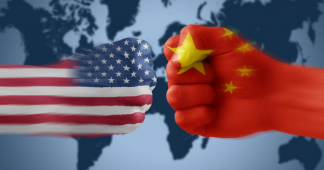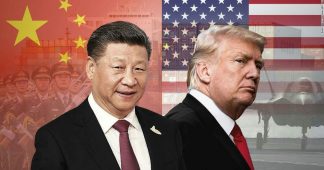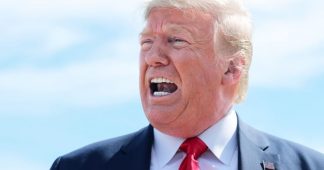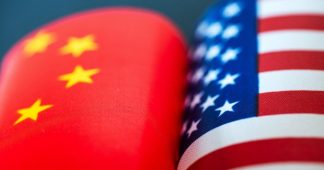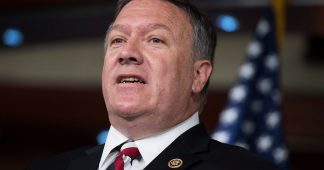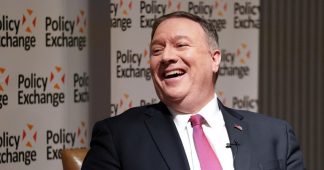Would a Joe Biden administration relieve pressure on China, with less antagonism? Though the rhetoric may be softened, the main thrust of US policy, to prevent Beijing from ever achieving international parity with Washington, is unlikely to change
by Michael T Klare,
14 October 2020
It has become common for journalists and politicians to speak of a ‘new cold war’ between the United States and China, comparing the current chill in Sino-American relations to the hostility that long prevailed between the US and the Soviet Union. But it would be a mistake to view the current situation as a replica of that earlier time, when the western powers sought to contain Soviet power through a strategy of unyielding encirclement. Rather than merely contain Chinese power, America’s current leaders seek to push back at Beijing, forcing it to abandon whatever geopolitical gains it has made over the past few decades.
This drive to counter China reflects a fundamental shift in elite American thinking regarding China’s role in world affairs. For many years, American leaders believed that China’s rise to great-power status could be managed in a way that did not harm fundamental US interests. As China gained in wealth and power, it was assumed, it would choose to integrate itself into an American-dominated world order that allowed Washington to retain control over the principal levers of power. Whether or not that assumption was ever correct to begin with, top leaders — both Democratic and Republican — no longer believe that Beijing will accede to an American-dominated world system, and are determined to prevent China from ever achieving parity with the US in global geopolitical might. Senior officials also believe that China took advantage of America’s costly and futile involvement in the Iraq and Afghanistan wars to secure significant geopolitical gains in Southeast Asia and the Pacific — gains that Washington now seeks to reverse.
Washington’s aggressive new stance toward China is on multiple levels — rhetorical, military, diplomatic and economic: a key architect of all this is Secretary of State Mike Pompeo who has made several highly belligerent statements on US-China relations. In the most inflammatory of these, at the Richard Nixon presidential library on 23 July, Pompeo adamantly rejected any accommodation with a rising China and called for a broad-based campaign to counter its gains in Asia and beyond. ‘We imagined [that] engagement with China would produce a future with bright promise of comity and cooperation,’ he said; but now, ‘we must admit a hard truth… that if we want to have a free 21st century, and not the Chinese century of which Xi Jinping dreams, the old paradigm of blind engagement with China simply won’t get it done. We must not continue it and we must not return to it.’
Instead, Pompeo declared, the US and its western allies must push back at China at every level: ‘We, the freedom-loving nations of the world, must induce China to change.’ This means, among other things, ceasing normal economic ties with China and treating all such commerce as a potential threat to western security. It also means viewing all Chinese students and scientists studying or working abroad as potential spies, and punishing those found to be working for Chinese government agencies. On the military front, it means ending years of ‘cheek-turning’ (as he called it) in the South China Sea, and resisting Chinese bullying of its neighbours there. And, in an especially chilling note, he implicitly called on the Chinese people to oust the current leadership. ‘Our approach can’t just be about getting tough,’ he declared. ‘We must also engage and empower the Chinese people — a dynamic, freedom-loving people who are completely distinct from the Chinese Communist Party.’
US military set for action
On the military front, American leaders seek to reverse what they see as an expansion of Chinese power from the mainland to the waters around it, especially the East and South China Seas. No issue has preoccupied American strategists more than China’s military presence in the South China Sea, a major throughway for international shipping and a potential source of oil and natural gas. China has long stationed naval forces in the area and, in recent years, has installed military installations on several islands there. Washington has repeatedly expressed its opposition to these moves, but until recently relied on diplomatic rather than military means to alter the situation; but now, in accordance with the harsher stance advocated by Pompeo, the US military is preparing to eliminate the Chinese presence by sheer force.
Underlying the tensions in the South China Sea is a fundamental dispute over ownership of the maritime features located there. As far back as 1946, under the nationalist regime of Chang Kai-shek, China claimed sovereignty over nearly the entire body of water along with the small reefs and islands located within it. However, with the ratification of the United Nations Convention on the Law of the Sea (UNCLOS) in 1982, other littoral states — Brunei, Indonesia, Malaysia, Vietnam, and the Philippines — laid claims to ‘exclusive economic zones’ (EEZs) extending well into the area claimed by Beijing. This has led, on occasion, to small-scale clashes between Chinese gunboats and vessels belonging to those other countries. In response, the Philippines sought to authenticate its claims in accordance with the juridical provisions of UNCLOS, and in July 2016 an Arbitral Tribunal in The Hague ruled that China’s claims to the entire region had no legal basis and that the EEZ claims of the other states were valid. China, however, has rejected the ruling and continued its practice of harassing fishing boats and drilling rigs belonging to the other countries.
From the US perspective, the question of competing claims to the South China Sea was a matter to be settled by the countries involved themselves. But when China began to enlarge some of the islands it claimed in the area and installing military installations on them, Washington perceived a direct threat to its strategic interests. Whereas US ships and planes traversing the region were once largely immune to attack by hostile forces, now they faced the possibility of interception by Chinese anti-air and anti-ship missiles — a situation considered intolerable by senior American officers. ‘China has fundamentally altered the physical and political landscape in the South China Sea through large scale land reclamation and by militarizing these reclaimed features,’ declared Admiral Harry B Harris Jr, Commander of the US Pacific Command, in April 2017.
Although never saying so in public, US military leaders never accepted China’s militarisation of those islands as irreversible; to the contrary, they have long conceived of scenarios in which the process could be reversed. Until recently, however, the nation’s top leaders opposed such a move, favouring diplomatic pressure instead — what Pompeo referred to as ‘cheek-turning’. But now, with the shift in policy at the top, US forces have been given a virtual carte blanche to counter China’s military moves in the South China Sea. On July 13, in a formal State Department memorandum, Pompeo stated that China’s claims to the South China Sea were ‘completely unlawful’. The US, he said, ‘stands with our Southeast Asian allies and partners in protecting their sovereign rights to offshore resources’ and will ‘oppose any attempt to use coercion or force to settle disputes.’
At the very least, this suggests that Washington is prepared to employ force to drive off any Chinese warships said to be interfering with the legitimate activities of those allies and partners when operating within their EEZs. In an early test of such manouevres, the Pentagon twice this spring sent a pair of Navy warships into waters claimed by Malaysia to drive off Chinese vessels said to be harassing a Malaysian-operated drillship in simulated attacks on nearby Chinese bases. In an even more ominous indication of U.S. intentions, 350 paratroopers from the Army’s 25th Infantry Division were flown from their home base in Alaska to Guam on July 1 to test their ability to seize an enemy air base in the Pacific.
It would appear, then, that it is only a matter of time before American authorities find a pretext to engage Chinese naval forces in the South China Sea and launch a full-scale operation to demolish China’s military installations on those disputed islands. After all, if you are no longer willing to engage in cheek-turning, the only option is violent force.
Arming Taiwan and girding for war
Another area where the shift in American policy toward China has become evident is in U.S. relations with Taiwan. Historically, the United States has acknowledged that both mainland China and Taiwan are both parts of a single sovereign entity called ‘China’ but has rejected Beijing’s assertion that Taiwan is a ‘rebel’ province that must, in time, be reunited with the mainland. Moreover, under the Taiwan Relations Act of 1979, the United States is obliged to provide Taiwan with whatever weapons it needs to defend itself against aggression. The 1979 act does not guaranty that the United States will come to Taiwan’s aid if it is invaded by mainland China, but it does not rule out that possibility, and American leaders have always hinted that they might do so, without making a firm statement to this effect. This ambiguity has served leaders from all three countries well, as it has discouraged aggressive moves by Beijing while allowing it to bide for time in its quest to reclaim Taiwan. Now, however, Washington appears to be suggesting that the time for ambiguity is over and that the United States is prepared to defend a wholly independent Taiwan — even if this means war with China.
Washington’s altered stance on Taiwan is evident on several levels. On the diplomatic level, the Trump administration has signalled its increased support for Taipei and its pro-independence president, Tsai Ing-wen, by sending two high-level officials there in recent months. The first to arrive, Secretary of Health and Human Services Alex M Azar II, met with President Tsai on 10 August — the first visit by an American cabinet member to the island since 1979. Azar’s visit was followed a month later by the arrival of Keith Krach, the under secretary of state economic growth, energy, and the environment and the highest-ranking State Department official to visit Taiwan in decades. Both visits were loudly protested by Beijing as an affront to US-China relations, and were accompanied by multiple incursions into Taiwanese airspace by Chinese fighter jets.
In addition to these diplomatic forays, the United States has commenced a series of major arms transfers to Taiwan. In 2019, the Trump administration announced its intention to sell 66 F-16 fighter jets to Taiwan, representing a major boost to the island’s air power. In yet a more provocative move, the administration said in September that it would sell the Taiwanese an advanced air-to-ground missile, the AGM-84H/K SLAM-ER (Standoff Land Attack Missile-Expanded Response), to equip those F-16s. Once armed with the missile, Taiwan’s air force would be able to attack targets on the Chinese mainland from ‘standoff’ locations beyond China’s robust air defences — a capacity they lacked before, and one that suggests an offensive rather than defensive intent.
In addition to these moves, the Department of Defense (DoD) has stepped up its own military activities in the area. It has increased the pace of “freedom of navigation” operations by US warships sailing through the Taiwan Strait and conducted numerous military exercises in the area. In yet another demonstration of US resolve, the Pentagon has flown nuclear-capable B-52 bombers over nearby waters. All these moves, in turn, have provoked numerous outcries from Beijing, along with periodic forays into the area by Chinese ships and planes. As in the South China Sea, therefore, the risk of an armed clash is ever-present.
Allies for an anti-China coalition
In a further drive to counter China’s geopolitical outreach in Asia, the United States is strengthening its military ties with allies in the region and attempting to weave them into an anti-China military coalition stretching all the way from Japan to Australia and across Southeast Asia to India. Such efforts, said Secretary of Defense Mark T Esper in July, are as important as America’s own military initiatives in the region. Alongside the ongoing US buildup, he declared, ‘we continue to bolster our growing network of Indo-Pacific allies and partners, a strategic advantage our competitors [meaning China] cannot match.’
As part of this effort, Esper noted, the DoD is increasing its engagement with such long-standing allies as Australia, Japan, Thailand, and South Korea, and pursuing expanded ties with new partners such as India. ‘I want to highlight our increased defense cooperation with India,’ Esper declared, calling this ‘one of the all-important defense relationships of the 21st century.’ In addition to an accelerated programme of joint military manoeuvres, Esper promised an increased level of US arms sales to India.
Under Washington’s leadership, India has been participating in joint military activities with Australia and Japan as well as with the United States, an arrangement commonly known as the ‘Quad’. At present a relatively loose arrangement, the Quad is now being fashioned into something more elaborate, with regular military exercises and security consultations. In an online discussion sponsored by the US-India Strategic Partnership Forum in September, Deputy Secretary of State Stephen Biegun indicated that Washington sought to formalise the Quad into something more closely resembling NATO. Our goal, he said, is to establish a bulwark against China by bringing the four countries together ‘in a more structured manner’. In time, he added, other countries would be invited to join the NATO-like arrangement, including Vietnam, South Korea, and New Zealand.
Tightening the noose
All of this, it appears, is intended to trap China within an ever-tightening gauntlet of hostile powers. Combine this with the economic pressure being imposed on China by the Trump administration in the form of sanctions, high tariffs, technology denials, and so on, and Secretary Pompeo’s strategy to ‘induce China to change’ begins to come into focus. Chinese leaders can choose to play by American rules and accept an inferior status in the world power system, he appears to be saying, or it risks a confrontation with American power from which it is bound to emerge battered and diminished.
Would a Joe Biden administration relieve the pressure on China and allow for less antagonistic relationship between Washington and Beijing? Some softening in rhetoric is likely, but the main thrust of US policy — to prevent China from ever achieving parity with the United States on the world stage — is unlikely to change. Biden’s foreign policy advisers have already expressed deep concern over China’s rise, and have espoused policies that closely align with those of the Trump administration in this particular area. (1)
For Chinese leaders, then, the path ahead will be full of landmines. The Chinese Communist Party (CCP) leadership is under enormous pressure from the general public to embrace a nationalistic stance and to vigorously assert Chinese sovereignty over Taiwan and the South China Sea. To retreat on these critical issues would be to undermine the legitimacy of the CCP and risk popular revolt; to aggressively counter the United States in those areas risks war and humiliation. American leaders are well aware of Beijing’s dilemma in this regard, and are certain to take advantage of it. The result, then, will be a time of constant crisis and war drumming in the Asia Pacific region.
* Michael T Klare is a professor at Hampshire College (Amherst, Massachusetts) and the author most recently of All Hell Breaking Loose: the Pentagon’s Perspective on Climate Change, Metropolitan Books, New York, 2019.
Red more at mondediplo.com
